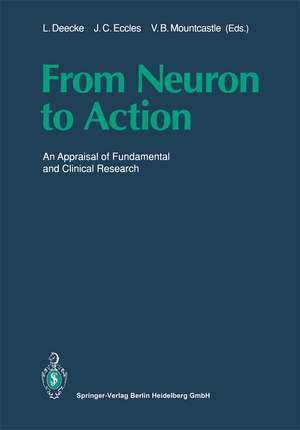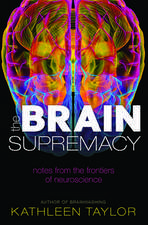From Neuron to Action: An Appraisal of Fundamental and Clinical Research
Editat de Lüder Deecke, John Eccles, Vernon B. Mountcastleen Limba Engleză Paperback – 21 dec 2012
Preț: 396.17 lei
Preț vechi: 417.02 lei
-5% Nou
Puncte Express: 594
Preț estimativ în valută:
75.82€ • 78.86$ • 62.59£
75.82€ • 78.86$ • 62.59£
Carte tipărită la comandă
Livrare economică 14-28 aprilie
Preluare comenzi: 021 569.72.76
Specificații
ISBN-13: 9783662026038
ISBN-10: 3662026031
Pagini: 700
Ilustrații: XXII, 677 p. 244 illus., 1 illus. in color.
Dimensiuni: 170 x 244 x 37 mm
Greutate: 1.1 kg
Ediția:Softcover reprint of the original 1st ed. 1990
Editura: Springer Berlin, Heidelberg
Colecția Springer
Locul publicării:Berlin, Heidelberg, Germany
ISBN-10: 3662026031
Pagini: 700
Ilustrații: XXII, 677 p. 244 illus., 1 illus. in color.
Dimensiuni: 170 x 244 x 37 mm
Greutate: 1.1 kg
Ediția:Softcover reprint of the original 1st ed. 1990
Editura: Springer Berlin, Heidelberg
Colecția Springer
Locul publicării:Berlin, Heidelberg, Germany
Public țintă
ResearchDescriere
A rich source of information about human voluntary movement in health and disease can be found in this book. The most esteemed researchers in their respective fields bring you up-to-date articles. Their collected work combines fundamental research in the life sciences with clinical neuroscience in a unique overview. The interdisciplinary aspects of motor physiology uncover a wealth of information for researchers from neighboring disciplines. For example, oculomotor research, vestibular research, equilibrium, sensory research and cognition, evolution, synaptic and elementary processes and the neurological sciences can be discovered.
Cuprins
1: Motor.- Adaptations and Learning of Arm Movements.- Emergent Issues in the Control of Multi-joint Movements.- Looking Where the Action Is: Negative DC Shifts as Indicators of Cortical Activity.- Negative DC Shifts of the Supplementary and Motor Area Preceding and Accompanying Simultaneous and Sequential Finger Movements.- DC Potential Shifts and Regional Cerebral Blood Flow Reveal Frontal Cortex Involvement in Human Visuomotor Learning.- Event-Related Slow Potentials Recorded from Cortex and Depth of the Human Brain.- Cortical DC-Shifts Related to Sustained Sensory Stimulation and Motor Activity.- Coordination Between Posture and Movement in Parkinsonism and SMA Lesion.- Feedback Mechanisms Controlling Skeletal Muscle Tone.- Significance of Carbonic Anhydrase in the Function of Skeletal Muscle.- 2: Oculomotor and Equilibrium.- Holding the Eye Still After a Saccade.- Do the Pretectum and Accessory Optic System Play Different Roles in Optokinetic Nystagmus?.- Excitatory and Inhibitory Mechanisms Involved in the Dynamic Control of Posture During the Vestibulospinal Reflexes.- Motion Perception with Moving Eyes.- Does the System for Smooth-Pursuit Eye Movements Rely on a Neuronal Representation of Target Motion in Space?.- Optokinetic and Smooth-Pursuit Response After Adaptive Modification of the Vestibulo-Ocular Reflex.- The Detection of Motion by the Vestibular System.- Role of Neck and Visual Afferents for Self and Object Motion Perception in Labyrinthine Defective Subjects.- The Coordination Between the Lid and Eye During Vertical Saccades.- Ocular Pursuit of Sinusoidally Moving Targets: Is There a Sine Wave Generator in the Brain?.- The Role of Visual Feedback and Preprogramming for Smooth Pursuit Eye Movements: Experiments with Velocity Steps.- Positional Nystagmus of Benign Paroxysmal Type (BPPN) due to Cerebellar Vermis Lesions: Pseudo-BPPN.- Two Forms of Head-Shaking Tests in Vestibular Examination.- 3: Sensory and Cognitive.- The Parietal Visual System and some Aspects of Visuospatial Perception.- Focal Thalamocortical Rhythms as Indicators of Attentive States in the Cat.- The Sensory Neuron — Where the Action Begins.- Parallel and Complementary Organization of Cortical Eye Movement Control and Visual Perception.- Stages of Somatosensory Processing Revealed by Mapping Event-Related Potentials.- On Ideation and “Ideography”.- Movement Detection and Figure-Ground Discrimination.- Influence of Complex Visual Stimuli on the Regional Cerebral Blood Flow.- DC Shifts in the Human Brain: Their Relationship to the CNV and Bereitschaftspotential.- Probability Mapping of EEG Changes due to the Perception of Music.- Program Generator Revisited: The Role of the Basal Ganglia in Language and Communication.- From Articular Nociception to Pain: Peripheral and Spinal Mechanisms.- 4: Evolution.- The Evolution of Cerebral Asymmetry.- Science, Man and Meaning.- Information and Efficiency.- A Critical Consideration of Kornhuber’s Concept of the Brain-Mind Problem.- Brain, Mind, Freedom: Beyond Metatheory, Nearer to Reality.- Neuroethological Foundations of Human Speech.- Cricket Neuroethology: A Comparative Approach to the Nervous System.- Hierarchies of Structure-Function Relationship in the Neurosciences.- Evolution and Phylogenetic Diversification of Chemical Messengers.- 5: Synaptic and Elementary Processes.- Cascade-Type Reentrance: The Major Connectivity Principle of the Neocortex.- Peripheral Axotomy Challenges the Central Motor Neuron and its Cellular Microenvironment.- Frequency and Amplitude Codes of Neuronal Signals.- Balance and Imbalance of Transsynaptic Neurotransmission as Conditions for Normal and Pathological Behaviour: Examples Only.- Behavioural Pharmacology of Brain Glutamate.- Effects of CO2 on Neuronal Functions.- The R-Wave Biography of a Brain Potential.- The Proton-Activated Sodium Current: Activation Conditions in Mammalian Central Neurons.- The Impact of Advanced Computing on Medicine.- Biomagnetic Measuring Technique: State of the Art and Prospects for the Future.- 6: Neurological Sciences I (Psychiatry).- Advances in Schizophrenia Research.- Cognitive Basic Symptoms of Thought, Perception and Action in Idiopathic Psychoses and Limbic System.- Phenomenological Aspects and the Measurement of Negative or Basic Symptoms in Schizophrenia.- Evoked Brain Potentials and Psychometric Data in Children at Risk for Schizophrenia.- The Order of EEG Activity of Schizophrenic Patients and the Influence of Haloperidol and Biperidene on the EEG Order of Healthy Subjects.- Progress in Neuropsychopharmacology: The Use of Thymosthenic Substances in Schizophrenia.- Dopamine D2 — Receptors in Post-mortem Human Brains from Schizophrenic Patients.- Phencyclidine — A Challenge to Schizophrenia Research.- Neurotoxic Metabolites of Tyrosine/Dopamine in Cerebrospinal Fluid and Serum of Normal Men and Neurological Patients: A Sign of the Activity of free Oxygen Radicals?.- Searching for New Antiischemic Compounds: Theoretical and Practical Aspects.- Experimental Intracerebral Hematoma and Treatment with Flunarizine in Rats.- “Normal” Alcohol Consumption and Well-Being: Relationship Between Reduction of Alcohol Consumption and Changes in Well-Being.- “Normal” (“Social”) Daily Alcohol Consumption, Arterial Hypertension, Glucose Tolerance, Plasma Insulin, C Peptide, GGT, S-Adenosylmethionine, Plasma Lipids and Obesity: Insulin Receptor Damage and Mediators Versus Repair Mechanism of Toxic Alcohol Effects.- EEG Signs of a Disturbed Voluntary Process Prior to Voluntary Movements in Schizophrenia.- 7: Neurological Sciences II (Neurology and Neurosurgery).- The Role of the Magnification Factor in the Recovery Process of Visual Field Defects After Retrogeniculate Lesions.- Oxygen Free Radicals and Radical Scavengers in Neurology.- Immunotherapy in Multiple Sclerosis: Current Status and Future Prospects.- Effective Treatment of Multiple Sclerosis with Cyclophosphamide with Little Side Effects.- Neurogenesis and Pathogenesis of Glia: Immunological Studies.- Paired Stimuli in the Diagnosis of Peripheral and Central Nervous Diseases.- Early Speech Education: An Epidemiologic Study.- Hope for a Drug Treatment in Acute Stroke.- The Essence of Aphasia — Disturbed Control of Language Production, e. g. in Phonemic Paraphasia: A Quantitative Comparison of Spontaneous Speech in Aphasia and Dementia.- Planning Strategies of Intracranial Microsurgery.- What Can Neurosurgery Do in 19887.- Transcranial Doppler Evaluation of Cerebral Hemodynamics in Carotid Artery Occlusions.- Sonography Through the Anterior Fontanelle in Newborns: An Efficient Method for Screening Pre- and Perinatal Lesions.- The Severity of Convulsive Behaviour in Rats: Disinhibitory Effects of Cortical Lesions.- Electrophysiology of Myotonias and Periodic Paralyses.- Protection Against Sudden Infant Death: Home Monitoring of All Infants During the First Year of Life by Means of the Baby protector.- EEG Spectra and Evoked Potentials to Words in Apallic Patients.











